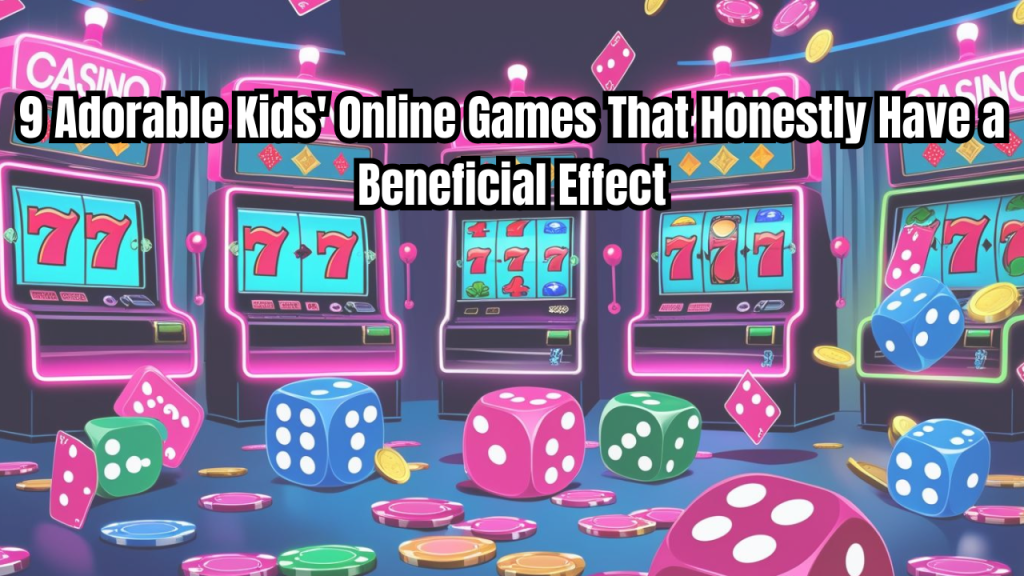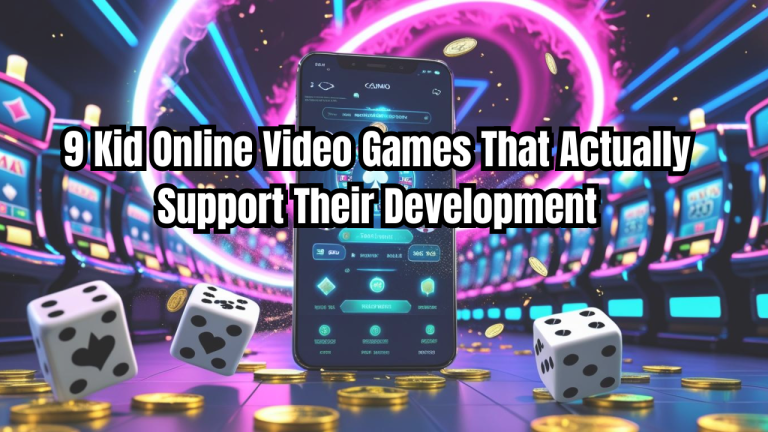It is undeniable that children are drawn to screens. Children today learn, play, and connect largely through digital experiences, whether on a tablet, computer, or smartphone. This presents a difficult question for many parents and educators: Can online games really be good for kids?

In a nutshell, the answer is yes— if you pick the right ones .
Online games can be more than just enjoyable diversion if they are chosen carefully. They can teach academic skills, foster creativity, hone critical thinking, and even aid in emotional growth. In this guide, we’ll examine 9 thoughtfully chosen entertaining games for kids fun games for kids online that have real advantages and explain why your child should play them.
—
The Reasons Screen Time Needn’t Be Wasted
Despite the temptation to see screen time as a necessary evil, it’s all about how that time is used . Not every fun game for kids online is made equally. While some are designed with child development, education, and creativity in mind , others are based on clickbait mechanics and shallow engagement.

The secret is to look for fun games for kids online girls that:
Age-appropriate and devoid of deceptive in-fun games for kids online without downloading purchases, they support cognitive or emotional development objectives, promote active rather than passive engagement, and offer lasting value rather than instant satisfaction.
Let’s examine nine internet games that effectively achieve that harmony.
1. A Math Prodigy Game
Best For: Adventure-based math mastery
By transforming math into a fantasy quest, Prodigy helps people overcome their fear of it. Children battle characters, level up, and explore a magical world by solving math problems. To keep them challenged but not overburdened, the curriculum adjusts to their level.
The Reason It Works:
Provides parents and teachers with comprehensive progress tracking Gamifies learning without using gimmicks Encourages confidence and retention in math
—
2. Toca Life World
Greatest For: Unstructured play and imagination
Children can create, design, and invent their own stories in the digital sandbox that Toca Life World offers. There is only a world of role-playing, characters, and unbridled creative freedom—neither winning nor losing.
The Reason It Works:
Promotes emotional exploration and story development Fosters creativity and free-form thought Removes advertisements and pressure to compete
—
3. ABCmouse
Best For: Young students developing foundational skills
A comprehensive preschool-to-early-elementary learning path covering subjects like reading, math, science, and art is provided by ABCmouse, which caters to children ages 2 to 8. Kids are kept interested by the gamified progress system and the user-friendly interface.
The Reason It Works:
More than 10,000 activities with quantifiable outcomes are included in the curriculum, which is structured and includes interactive reinforcement to encourage independent learning habits.
—
4. Education Edition of Minecraft
Best For: STEM education and teamwork
The educational version of Minecraft gives the sandbox fun games for kids online that kids already enjoy a deeper level of complexity. It offers supervised instruction in history, physics, coding, and even sustainable agriculture. It is popular in classrooms because it emphasizes collaboration and project-based learning.
The Reason It Works:
Logic, spatial awareness, and digital literacy are taught; peer communication and collaborative learning are supported; and creative problem-solving is encouraged.
—
5. PBS Kids Games
Greatest For: Secure early education with cherished characters
Short, developmentally appropriate games are available on PBS Kids fun games for kids online , which are based on the channel’s well-liked educational programs. Through delicate, skillfully designed experiences, these games teach important life concepts, from vocabulary development to emotional comprehension.
The Reason It Works:
Developed in collaboration with child psychologists and educators No tracking or advertising strengthens what is learned in class at home
—
6. Lightbot
Greatest For: Learning the basics of coding through logic puzzles
Lightbot uses simple puzzles to teach programming concepts like conditionals, loops, and sequencing. Without typing a single line, children control a robot by resolving puzzles that resemble fundamental coding logic.
The Reason It Works:
Increases interest in STEM and reasoning abilities All learners benefit from nonverbal learning Self-paced learning promotes problem-solving skills.
—
7. BrainPOP Jr.
Best For: Understanding difficult subjects in easy-to-understand ways
BrainPOP Jr. explains everything from grammar to emotional control through animation. It is an excellent resource for both home and school settings because it consists of brief videos followed by fun games for kids online free and activities that reinforce each lesson.
The Reason It Works:
Age-appropriate content makes complex subjects easier to understand; it encourages reflection and discussion; and it aids in the development of comprehension and memory skills.
—
8. Kodable
Best For: Teaching children under ten programming
Kodable blends structured, progressive computer science lessons with vibrant visuals. Children solve puzzles and earn rewards while navigating mazes with commands that gradually lead to actual coding knowledge.
The Reason It Works:
Provides practical coding foundations Is self-directed and adaptable to various age groups Easily incorporates into school curricula
—
9. Kids from National Geographic
Ideal For: Exploration is the means by which we learn about the world.
Nature, animals, geography, and conservation are the subjects of the games, tests, and activities offered by National Geographic Kids. It engages children with real-world subjects in a way that feels more like play than study thanks to its stunning graphics and abundant content.
The Reason It Works:
Promotes reading and research Arouses curiosity about the world and the environment Perfect for self-directed, interest-based education

—
Doable Steps: How to Pick the Best Online Games
It doesn’t have to be difficult to choose the best fun games for kids online for your child. Here is a brief framework to assist:
1. Establish Objectives
Do you prioritize emotional growth, creative thinking, or math reinforcement? Consider your child’s needs when selecting games.
2. Check for Quality
Examine reviews, look for educational partnerships, and make sure in-app purchases and advertisements are transparent.
3. Examine Involvement
Play the game with your child or give it a try yourself. Observe their interactions to see if they are thinking, learning, or producing.
4. Establish Limits
Strike a balance between online and offline activities. Set time limits, but pay more attention to what they’re playing than how long .
Common Questions: fun games for kids online
Q: How much time should children spend playing online games every day?
A: According to the American Academy of Pediatrics, children between the ages of 2 and 5 should ideally play for less than an hour every day, while older children should have reasonable limits. Quantity is not as important as quality.
Q: Are these games safe from inappropriate content or online predators?
A: In agreement. Every fun games for kids online on this list is made for kid-friendly settings free of unmoderated chat and advertisements.
Q: My kid only wants to play games that aren’t educational. How can I help?
A: Begin by playing cooperative games that strike a balance between enjoyment and education. Kids frequently object to “educational” games because they sound like labor, but these titles are entertaining enough to dispel that misconception.
Q: Can children with special learning needs benefit from playing online games?
A: Definitely. Numerous games listed accommodate a variety of learning styles, including slower-paced or self-directed play, visual and auditory processing, and more, making them appropriate for a broad spectrum of students.
Conclusion: There Are Uses for Play
Selecting the appropriate online games is not only wise, but also necessary in a world where technology permeates practically every aspect of childhood. The objective is to increase screen time rather than to completely eradicate it. The nine games we’ve discussed demonstrate that children can develop, learn, and reach their full potential through play without compromising enjoyment.

Through the provision of secure, stimulating, and developmentally appropriate digital experiences, these games assist kids in developing practical skills while having fun . Children and those who care about them both benefit from that.






